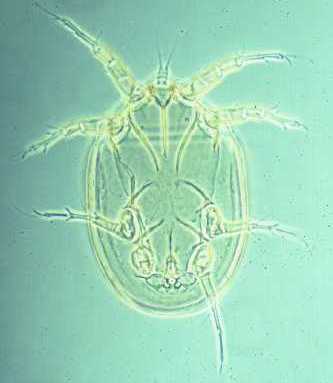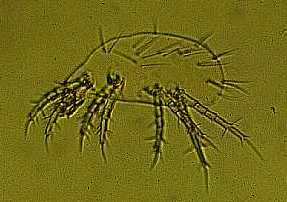 |
| Sarraceniopus sp. (deutonymph)
ventral view |
 |
| Sarraceniopus sp. (deutonymph)
ventral view |
Mites are one of the most species-rich groups of arthropods that inhabit pitchers. Two families of mites occur in this habitat, Histiostomatidae (suborder Astigmata) and Phytoseiidae (suborder Mesostigmata). The phytoseiids are represented by one species of fast-running predator, Macroseius biscutatus. The histiostomatids are a far larger group, with at least ten species of the genus Sarraceniopus living in pitcher plants. Sarraceniopus mites crawl slowly through prey remains in bases of pitchers, apparently filter-feeding on bacteria. Both Macroseius and Sarraceniopus are obligate symbionts of Sarraceniaceae, requiring pitchers to complete their life cycles. Our studies focus on the systematics of Sarraceniopus, since this genus is far less studied than Macroseius.
Macroseius are relatively large mites, with females (the largest stage of the life cycle) about the size of a pinhead. Sarraceniopus mites are much smaller, with the females only about 50% the length of Macroseius females. Macroseius are relatively easily seen with the naked eye, especially as they run on the interiors of pitchers. Sarraceniopus are just barely visible without magnification. Members of both genera are ivory-colored when alive, but transparent when cleared for microscopic study, as seen above and below.
Mites, like other arthropods, molt several times during their lifespan.
Thus, an individual mite proceeds through several instars, including
larva, various nymphs, and adults (males and females). For pitcher
plant mites, the deutonymph (the second nymphal instar) is the usual dispersal
stage.
 |
 |
|
|
ventral view |
lateral view (showing feeding position) |